
Aussie Siberians are a mix between a purebred Australian Shepherd and a Siberian Husky. They are bred for their enthusiasm, size, and intelligence, making them great companions and security animals. This breed is known for being highly trainable, but they can also be hyperactive and stubborn. Aussie Siberians love to explore and need access to the outdoors and plenty of exercise. With their double-coated, weather-resistant fur, they are well-equipped to handle any weather conditions. On average, they weigh between 40 and 65 pounds and have a lifespan of 11 to 13 years. If given enough attention and exercise, Aussie Siberians are devoted and affectionate family dogs.
In summary, Aussie Siberians are a mix between an Australian Shepherd and a Siberian Husky. They are known for their enthusiasm, size, and intelligence, making them excellent companions and security animals. They are highly trainable but can also be hyperactive and stubborn. Aussie Siberians love to explore and need outdoor access and lots of exercise. With their weather-resistant coat, they can handle any weather conditions. They weigh between 40 and 65 pounds on average and live for about 11 to 13 years. When given proper attention and exercise, they make wonderful family dogs, known for their loyalty and affection.
Ahead, we look at Aussie Siberian dog breed, its history, personality, pros and cons of owning an Aussie Siberian, characteristics, and must-know facts. We will also examine how to care for this breed and much more. Prepare for a tail-wagging adventure into the world of Aussie Siberians!
| Dog Breed | Aussie Siberian |
| Size | Large |
| Weight | 35-65 lbs (average) |
| Height | 18-25″ (average) |
| Location | United States, United Kingdom, Ireland |
| Ancestry | Australian Shepherd, Soft Coated Wheaten |
| Date of Origin | Unknown |
| Group | Companion, herding, hunting |
| Life Expectancy | 12-14 years |
| Price | $700 – $1200 |
| Family | Canidae |
| Scientific Name | Canis Lupus Familiaris |
📖 Breed History
The name Aussie Siberian comes from its two parent breeds, the Australian Shepherd and the Siberian Husky. The Australian Shepherd, despite its name, actually originated from the United States and was bred in the early 1900s to herd sheep in the western part of the country. They have since become popular as working dogs and family pets. The Siberian Husky, on the other hand, has a lineage that dates back over 3,000 years and was originally bred as sled dogs in arctic regions. They are now one of the most popular arctic breeds.
Although the exact origin of the Aussie Siberian breed is unknown, it is believed that Australian Shepherds and Huskies have been bred together for many years. These dogs typically inherit the high energy levels and stubbornness of their Husky parent, as well as the protective and affectionate nature of their Shepherd parent. It’s important to note that Aussie Siberians are not recognized by the American Kennel Club (AKC) because they are not purebred. If you are interested in getting an Aussie Siberian, it is recommended to thoroughly research breeders before making a purchase.

🐕 Aussie Siberian Appearance
Due to their Shepherd ancestry, Aussie Siberians sometimes have a shaggier appearance than Huskies. They are big canines with a strong, muscular frame. Average weights for men and women are between 40 and 60 pounds for men and 35 to 55 pounds for women. Typically, women are 18 to 21 inches tall, but men are typically 20 to 24 inches tall. The breed’s short to medium-length coat typically features two colors that dominate. From the breast to the stomach, as well as the legs and paws, the animal is covered in one hue. The remainder of its body is dominated by the opposite hue. A solid color, such as white, black, brown, cream, or gray, serves as the base color most often. They have a thick, water-resistant covering as well. Aussie Siberians feature oval eyes that can have a variety of hues, triangle-shaped ears that flap over, a tapering nose with a level bite, and alert, interested attitudes. Their tail is proportionate and well coated, and their paws are broad and tough.
| 👀 Eye Color | Varies |
| 🐽 Nose Color | N/A |
| 🐕 Coat Color | Ranges |
⚡ Fun Fact: Aussie Siberian dogs are a social breed. They enjoy being around people or other animals. This breed doesn’t tolerate being left alone.
🐶 Traits & Temperament of Aussie Siberian
We are reviewing and looking at the data related to the temperament, behavior, and traits of this dog breed. Please stay tuned for our update available shortly.
🤝 Are Aussie Siberians Friendly or Aggressive?
Aussie Siberian dogs tend to have difficulty getting along with other pets. Although they are generally friendly towards strangers, they are especially fond of children and enjoy being in their company. However, they may not be the most compatible with cats. On the other hand, Aussie Siberians are quite friendly towards other dogs, making them a good choice for those looking to have multiple dogs or participate in dog meetups. Additionally, they are considered one of the top breeds for elderly individuals, as they can provide companionship and support.
This breed is known for being:
- Active
- Loving
- Protective
- Alert
- Intelligent
- Friendly
- Outgoing
- Affectionate
- Gentle
- Good-natured
🐩 Aussie Siberian Care & Maintenance
In general, Aussie Siberians make low-maintenance pets. Although their short to medium-length coats don’t need to be clipped or styled, these canines are not hypoallergenic. It is true that this breed sheds a lot at least twice a year. Continuous shedding can be decreased by regularly brushing with a brush with strong bristles. This breed’s owners should try to frequently clean its eyes and ears in addition to bathing it as needed. Like other breeds, Aussie Siberians should have their nails cut around once a month and their teeth washed every day. However, owners should take extra care to check their Aussie Siberians for any outdoor debris or ticks that can get entangled in their coats while they are out and about.
Aussie Siberian dogs have a higher than average rate of shedding. This is a normal part of their hair growth cycle. The amount and frequency of shedding can vary depending on the dog’s health and breed. If you don’t enjoy vacuuming, you might want to think twice about getting a puppy from the Aussie Siberian breed. Additionally, these dogs typically require bathing every 6-8 weeks.
🍖 Food: We recommend few cups daily, costing you about $0.49 – $1.49 daily, or roughly $30.00 a month.
🐾 Exercise: Aussie Siberian dogs need a lot of exercises. Long walks should be on a daily schedule. If you live an active life, this breed can be a good choice for you.
This dog breed requires to be walked for roughly few miles per week, which equates to about 15 – 35 minutes of physical activity daily. This consistent moderate exercise regimen will help maintain their physical wellness and significantly contribute to their mental stimulation. Consciously setting aside this time for your furry friend can dramatically enhance their life quality, helping them stay energetic, healthy, and mentally alert.
Did you know: Aussie Siberian dogs are high-energy dogs. An active lifestyle makes them happy.
❤️🩹 Aussie Siberian Health & Issues
Some of the major concerns for Aussie Siberian Dog Breed can be:
- Elbow Dysplasia
- Cataracts
- Hip Dysplasia
- Epilepsy
While minor concerns include:
- Progressive Retinal Atrophy
- Collie Eye Anomaly
- Heat Stroke
🤧 Important: Is Aussie Siberian hypoallergenic? No.
✨ Bonus: Check out cool, creative, and funny names for Aussie Siberian.
⚡ Aussie Siberian Dog Breed Facts
What makes the Aussie Siberian a great choice for families with young children?
The Aussie Siberian is a great choice for families with young children because they are known to be loyal and sweet pets. They can form strong bonds with children and provide them with companionship and security.
Is the Aussie Siberian breed considered a suitable breed for apartment living?
The Aussie Siberian breed is not considered suitable for apartment living. They are active and energetic dogs that require access to outdoor spaces and significant exercise. Living in an apartment may not provide them with enough space to fulfill their exercise needs.
How much exercise does a Aussie Siberian require compared to other breeds?
Compared to other breeds, the Aussie Siberian requires a high amount of exercise. They are hyperactive and explorers by nature, so they need plenty of physical and mental stimulation to prevent boredom and destructive behavior.
Is the Aussie Siberian breed known for being good with other pets?
The Aussie Siberian breed can be good with other pets if properly socialized from a young age. However, they may have a strong prey drive due to their Siberian Husky heritage, so caution should be exercised when introducing them to smaller animals.
What are other low-maintenance dog breeds similar to the Aussie Siberian?
Other low-maintenance dog breeds similar to the Aussie Siberian include the Labrador Retriever, Boxer, and Vizsla. These breeds are known for their friendly and easygoing nature, requiring moderate exercise and minimal grooming.
What are the common health issues that Aussie Siberians are prone to?
Common health issues that Aussie Siberians are prone to include hip dysplasia, epilepsy, and eye problems such as cataracts and progressive retinal atrophy. Regular veterinary check-ups and a healthy diet are important to maintain their overall well-being.
Are Aussie Siberians known to be easy to train compared to other breeds?
The Aussie Siberian breed is known to be highly trainable, but they can also be stubborn at times. Consistent and positive reinforcement training methods work best with them, and early socialization is crucial to ensure they grow up to be well-behaved dogs.
Are Aussie Siberians more prone to separation anxiety compared to other breeds?
Aussie Siberians may be more prone to separation anxiety compared to other breeds due to their loyal and affectionate nature. They thrive on companionship and may become anxious or exhibit destructive behavior when left alone for long periods of time.
Are there any dog breeds similar to the Aussie Siberian that are suitable for people with allergies?
For people with allergies, dog breeds similar to the Aussie Siberian that are suitable include the Poodle, Bichon Frise, and Portuguese Water Dog. These breeds have hypoallergenic coats that produce fewer allergens, making them more suitable for allergy sufferers.
What sizes of dogs similar to the Aussie Siberian are best for individuals or families with limited space?
Dog sizes similar to the Aussie Siberian that are best for individuals or families with limited space include small to medium-sized breeds such as the Cocker Spaniel, Beagle, and French Bulldog. These breeds can adapt well to smaller living spaces.
Is the Aussie Siberian breed known to be good with children with special needs?
The Aussie Siberian breed can be good with children with special needs, but it is important to supervise interactions and ensure proper training and socialization. Their size and energy levels should be taken into consideration when determining compatibility.
How does the grooming and shedding needs of the Aussie Siberian?
The grooming and shedding needs of the Aussie Siberian are moderate to high. They have a double-coated, weather-resistant coat that requires regular brushing to prevent matting and shedding. They shed seasonally and may require more frequent grooming during these times.
We use reliable and publicly available data and resources such as AKC and American Canine Registry to ensure that Aussie Siberian dog breed information is accurate and up to date. If you spot an error, please don’t hesitate to bring it to our attention.